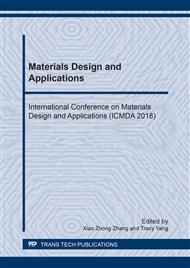[1]
K. Welsher, Z. Liu, D. Daranciang, H. Dai, Selective Probing and Imaging of Cells with Single Walled Carbon Nanotubes as Near-Infrared Fluorescent Molecules,, Nano Lett., vol. 8, 2008, pp.586-590.
DOI: 10.1021/nl072949q
Google Scholar
[2]
Y. Yao, Z. Li, C.P. Wong, Quality control of vertically aligned carbon nanotubes grown by chemical vapor deposition,, IEEE Transactions On Components, Packaging And Manufacturing Technology, vol. 3, 2013, Issue 11.
DOI: 10.1109/tcpmt.2013.2278174
Google Scholar
[3]
D. B. Geohegan, A. A. Puretzky, I. N. Ivanov, S. Jesse, G. Eres, In situ growth rate measurements and length control during chemical vapor deposition of vertically aligned multiwall carbon nanotubes,, App. Phys. Lett., vol. 83(9), (2003).
DOI: 10.1063/1.1605793
Google Scholar
[4]
W. Lin, R. V. Olivares, Q. Liang, R. Zhang, K. S. Moon, C. P. Wong, Vertically Aligned Carbon Nanotubes on Copper Substrates for Applications as Thermal Interface Materials: from Synthesis to Assembly,, Electronic Components and Technology Conference, 2009, ISSN: 978-1-4244-4476-2/09.
DOI: 10.1109/ectc.2009.5074051
Google Scholar
[5]
H. Hongo, F. Nihey, T. Ichihashu, Y. Ochiai. M. Yudasaka, S. Iijima, Support materials based on converted aluminium films for chemical vapor deposition growth of single-wall carbon nanotubes,, Chem. Phys. Lett., vol. 380, 2003, pp.158-164.
DOI: 10.1016/j.cplett.2003.08.103
Google Scholar
[6]
Y. Yao, Q. Li, J. Zhang, R. Liu, L. Jiao, Y. T. Zhu, Z. Liu, Temperature-mediated growth of single-walled carbon-nanotube intramolecular junctions,, Nat. Mater., vol. 6, 2007, p.283–286.
DOI: 10.1038/nmat1865
Google Scholar
[7]
Y. Suzuki, E. Pabjanczyk-Wlazlo, J. Onoda, T. Shimizu, M. Yang, Fabrication and evaluation of micro-structured reaction field with vertically aligned carbon nanotubes for micro bio-analysis device,, Mech. Eng. Journal, ID: 15-00567, doi.org/10.1299/mej.15-00567.
DOI: 10.1299/mej.15-00567
Google Scholar
[8]
Y. Suzuki, K. Morioka, S. Ohata, T. Shimizu, H. Nakajima, K. Uchiyama, M. Yang, Rapid ELISA using a film-stack reaction field with micropillar arrays,, Sensors, vol. 11; 17(7), 2017.
DOI: 10.3390/s17071608
Google Scholar
[9]
Y. Suzuki, K. Morioka, T. Shimizu, H. Nakajima, K. Uchiyama, M. Yang, Influence of structural dimensions of micro-pillar array in reaction field on sensitivity of enzyme-linked immunosorbent assay (ELISA),, Biotech. Equip. May 2017, doi: http://dx.doi.org/10.1080/13102818.2017.1327331.
DOI: 10.1080/13102818.2017.1327331
Google Scholar
[10]
M.S. Dresselhaus, G. Dresselhaus, R. Saito, Physics of carbon nanotubes,, Carbon, vol. 33(7), 1995, p.883–891.
DOI: 10.1016/0008-6223(95)00017-8
Google Scholar
[11]
Y. Yao, Q. Li, J. Zhang, R. Liu, L. Jiao, Y. T. Zhu, Z. Liu, Temperature-mediated growth of single-walled carbon-nanotube intramolecular junctions,, Nat. Mater., vol. 6, 2007, p.283–286.
DOI: 10.1038/nmat1865
Google Scholar


